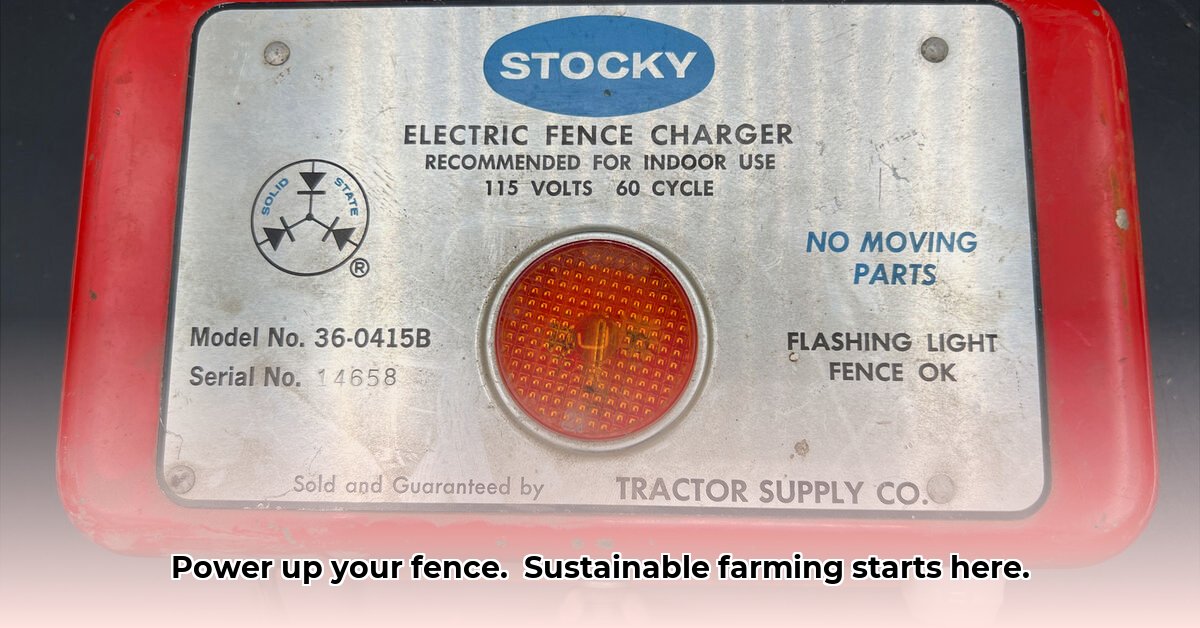
Choosing the right electric fence charger is crucial for efficient and sustainable farming practices. This guide focuses on the options available at Tractor Supply, providing a data-driven comparison to help you select the best charger for your specific needs and budget. We'll examine key factors, compare available models, and highlight areas where further research would be beneficial. For installing your fence, consider using a powerful post driver.
Understanding Joules: The Power Behind Your Fence
The most critical specification of any electric fence charger is its joule rating. Joules represent the energy delivered in each electrical pulse, directly influencing the fence's effectiveness. A higher joule rating equates to a stronger pulse, essential for containing larger animals or managing longer fence lines. But what joule rating do you need?
The required joule rating depends on several interacting factors:
- Animal Size: Larger animals like cattle require significantly higher joule ratings than smaller animals like sheep or goats. A weaker charger will prove ineffective against larger animals.
- Fence Length: Longer fences necessitate higher joule ratings to ensure a consistent pulse across the entire length. The longer the fence, the more energy needed to overcome resistance.
- Terrain: Uneven terrain, heavily wooded areas, or obstacles can weaken the electrical pulse. A more powerful charger may be necessary to compensate for signal loss.
Tractor Supply offers chargers with varying joule ratings, ranging from low-joule models suitable for smaller pastures and livestock to high-joule models ideal for larger operations. While Tractor Supply's website features customer reviews, a comprehensive comparison of performance across diverse conditions is needed for a truly informed decision.
Power Sources: Solar vs. AC
Tractor Supply offers both solar-powered and AC-powered fence chargers. Each presents unique advantages and disadvantages regarding sustainability and reliability.
Solar Chargers: These represent an environmentally friendly choice, minimizing reliance on the electricity grid. However, their effectiveness depends entirely on sunlight availability and intensity, potentially resulting in a weaker fence during cloudy periods. Further research into specific battery life and replacement costs is necessary for a comprehensive evaluation.
AC Chargers: These provide a consistent power supply, offering greater reliability. They typically boast higher joule outputs than solar chargers. However, AC chargers increase your reliance on and cost for grid electricity. A detailed cost-benefit analysis comparing the long-term running costs of AC chargers with the initial investment and maintenance of solar chargers and their batteries remains crucial for making an informed decision.
The optimal choice depends on several factors including your budget, energy access, and environmental considerations. Evaluating long-term maintenance costs for both types of chargers is essential for responsible decision-making.
Charger Comparison: A Preliminary Overview
The following table provides a preliminary comparison of some chargers found at Tractor Supply. Note that this data is limited, and additional information is needed for a more complete analysis. More detailed, specification sheets and independent testing would significantly benefit potential purchasers.
| Feature | American Farm Works 0.1 Joule (Solar) | American Farm Works 1.2 Joule (AC) | Gallagher M5800i (58 Joule AC) |
|---|---|---|---|
| Joule Output | 0.1 Joule | 1.2 Joule | 58 Joule |
| Power Source | Solar | AC | AC |
| Tractor Supply Rating | 4.4 stars | 4.6 stars | Not Available |
| Ideal Use | Small animals, short fences | Medium animals, medium fences | Large animals, large fences |
Data Gaps and Future Research Needs
The current information available on electric fence chargers at Tractor Supply is insufficient for making truly informed decisions. Further research is critical in the following areas:
- Fence Coverage: Precise data on the effective fence length or acreage each charger can power is crucial.
- Animal Suitability: Clear guidelines on the suitability of each charger for different animal types (based on size and temperament) would greatly enhance the decision-making process.
- Safety Features: Detailed information on built-in safety features for both animals and humans is essential for responsible usage.
- Energy Consumption: Precise energy consumption data for both AC and solar chargers are necessary for a thorough cost comparison and sustainability analysis.
- Longevity: Comprehensive data on the lifespan of each charger, including battery life for solar models, is needed to evaluate long-term cost-effectiveness.
Choosing the Right Charger: A Step-by-Step Guide
Selecting the most suitable electric fence charger involves a multi-step process:
- Assess Your Needs: Determine the length of your fence, the type of animals, and the terrain.
- Evaluate Power Sources: Weigh the pros and cons of solar, battery, and AC chargers based on your energy usage, budget, and environmental preferences. Consider the long-term maintenance and replacement costs.
- Determine Joule Requirements: Consult resources or experts to determine the appropriate joule rating for your specific setup, considering the size and temperament of your animals.
- Check Grounding and Wire Gauge: Ensure proper grounding based on your soil type and use appropriately sized wire.
- Review Tractor Supply Options: Compare charger specifications carefully, considering joule output, power source, warranty, and customer reviews.
- Evaluate Long-Term Costs: Factor in not only the initial cost but also running costs (electricity, battery replacement) and the product’s expected lifespan.
By following these steps, farmers can choose a fence charger that aligns with their sustainability goals and enhances the welfare of their animals. The availability of additional data will further empower farmers to make the best choice for their operations.